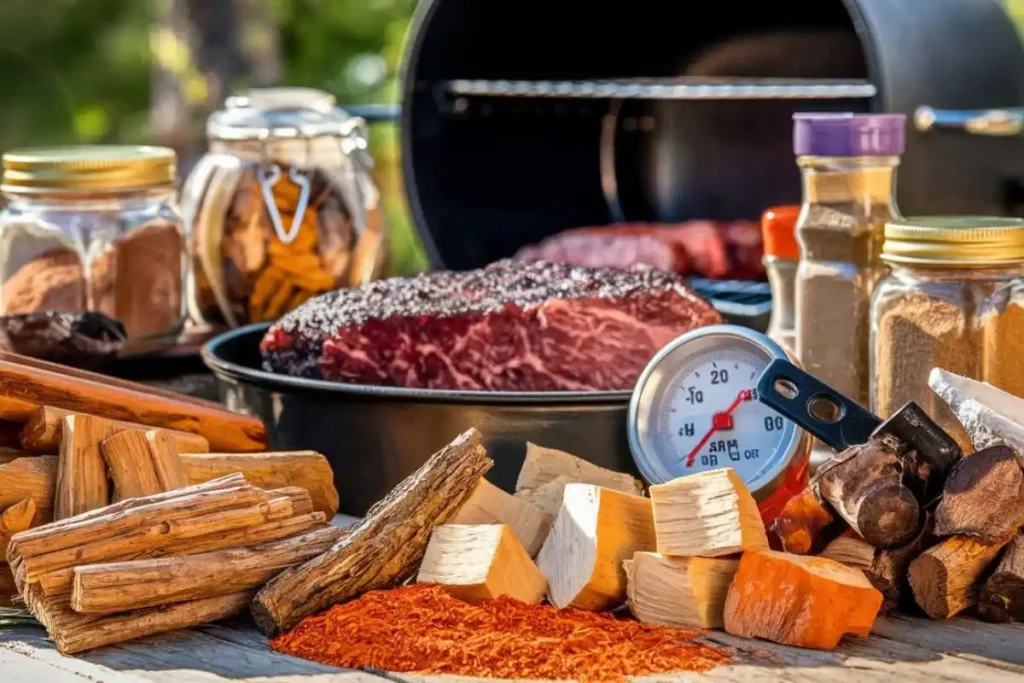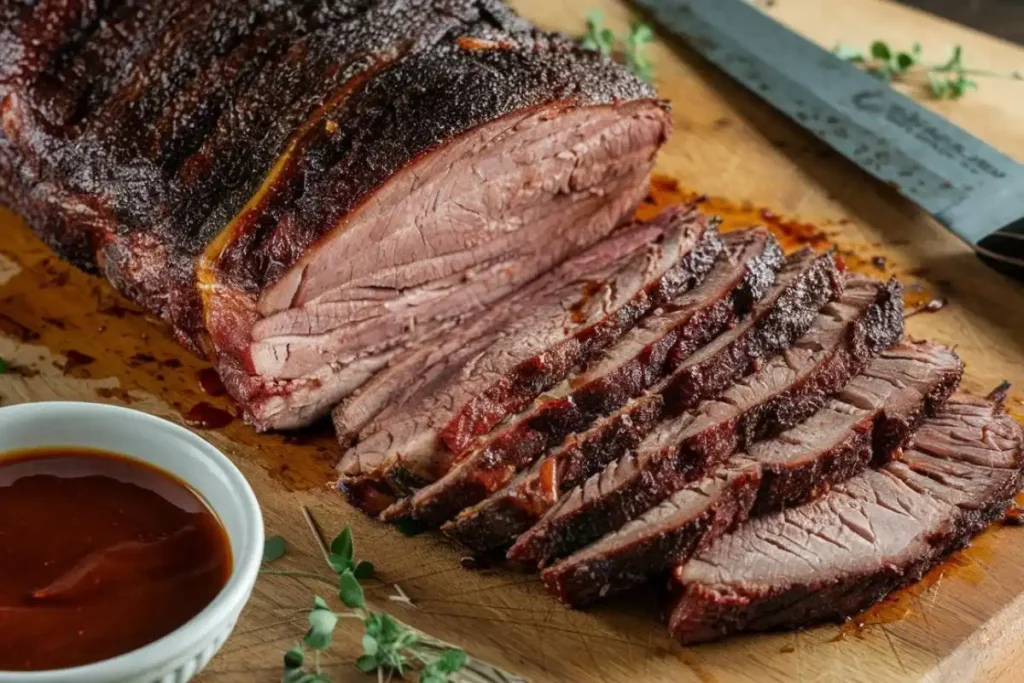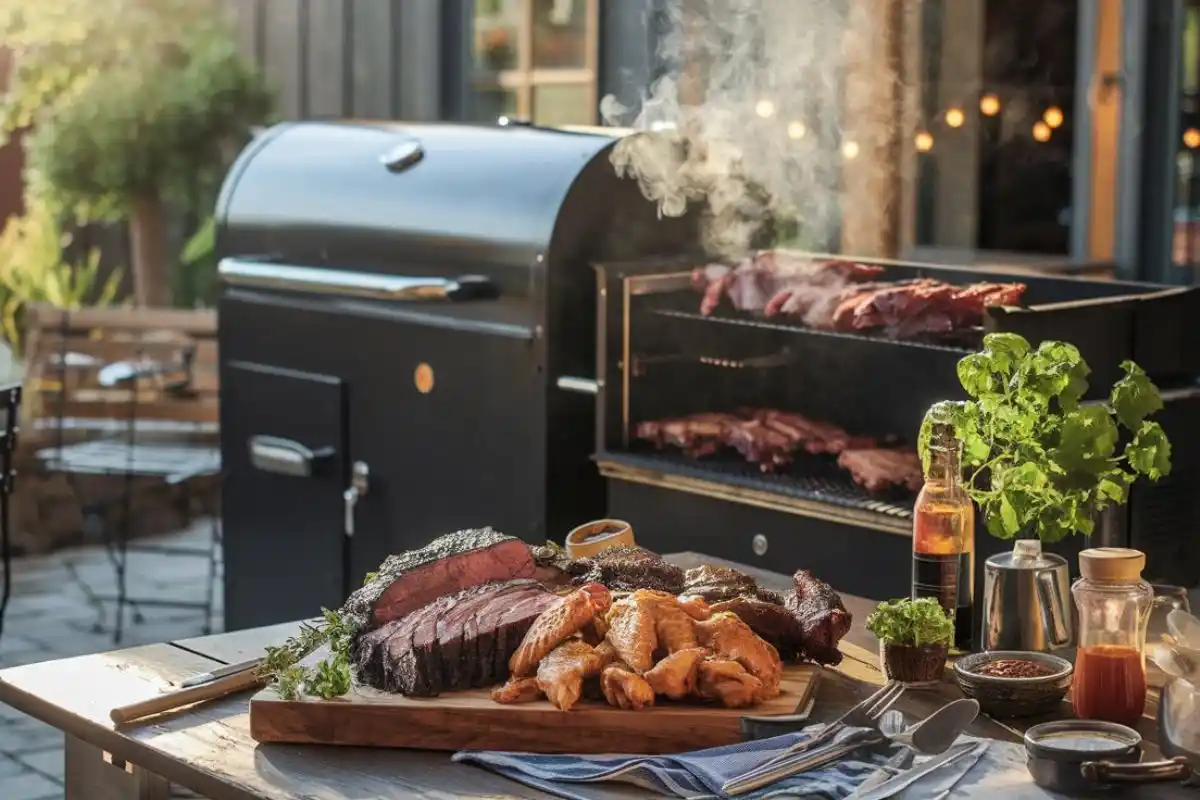Smoking food isn’t just cooking; it’s an art. From creating mouthwatering flavors to perfecting techniques, mastering the smoker opens up a world of possibilities for barbecue enthusiasts and home chefs alike. In this guide, we’ll dive deep into everything you need to know about smoker recipes, including the best types of smokers, essential tools, and must-try recipes. Whether you’re a novice or a seasoned pitmaster, this article will help you elevate your smoking game to the next level.
Introduction to Smoking
What is Smoking?
Smoking is a cooking method that uses low heat and slow cooking times to infuse food with the rich, deep flavors of wood smoke. Unlike grilling, which relies on direct heat, smoking surrounds the food with smoke, thus creating tender, flavorful dishes that are hard to beat.
This method has been cherished for centuries, from indigenous communities using smoking to preserve meat to modern barbecue enthusiasts crafting culinary masterpieces. The magic lies in the balance of heat, time, and wood selection.
Benefits of Smoking Food
Why choose smoking over other cooking methods? Here’s the scoop:
- Flavor explosion: Smoking infuses food with distinct, smoky aromas and tastes that other methods can’t replicate. In addition, the smoky flavor adds depth and complexity to dishes.
- Tender textures: The low-and-slow process breaks down tough meat fibers, yielding juicy, melt-in-your-mouth results. Thus, it’s an ideal method for cuts like brisket or ribs.
- Preservation: Smoking has its roots in preserving food, making it ideal for long-lasting flavors and storage.
The best part? You can smoke almost anything – from brisket and ribs to fish, cheese, and even vegetables.
Essential Equipment for Smoked Meat Recipes
Getting started with smoking requires some basic tools:
- Smoker: Whether it’s an offset smoker, pellet grill, or electric smoker, this is your primary tool. Each type offers unique benefits, which we’ll discuss in the next section.
- Thermometer: Precision matters. A reliable meat thermometer ensures your dishes are cooked to perfection.
- Wood chips or chunks: Different woods bring unique flavors, such as hickory for boldness or applewood for a milder, sweet note.
Ready to start smoking? Great! In the next section, we’ll explore the various types of smokers and which one suits your cooking style.
Popular Types of Smokers
When diving into smoker recipes, choosing the right smoker is crucial. Each type offers unique features that can influence your cooking experience and the flavors you achieve.
Offset Smokers
Offset smokers, also known as barrel smokers, feature a horizontal cooking chamber with a firebox attached to the side. This design allows for indirect heat and smoke to flow into the cooking chamber, thus providing that authentic smoky flavor. However, they require regular attention to maintain consistent temperatures but are favored by traditionalists for their capacity to produce rich, smoky results.
Pellet Smokers
Pellet smokers utilize compressed wood pellets as fuel, automatically feeding them into a firepot to maintain set temperatures. In addition to their convenience, they offer the flavor benefits of wood smoking. Ideal for those who prefer a “set it and forget it” approach, pellet smokers are versatile and can handle a variety of smoker recipes with ease.
Electric Smokers
Electric smokers use electricity to heat a rod, which then smolders wood chips to produce smoke. They are user-friendly, providing precise temperature control and requiring minimal supervision. However, while they may lack some of the depth of flavor achieved with charcoal or wood smokers, their ease of use makes them popular among beginners exploring smoker recipes.
Kamado Grills
Kamado grills are egg-shaped, ceramic smokers known for their excellent heat retention and versatility. They can function as grills, ovens, or smokers, thus accommodating a wide range of cooking styles. Their design allows for both high-temperature grilling and low-and-slow smoking, making them a favorite for enthusiasts looking to experiment with diverse smoker recipes.
Selecting the right smoker depends on your personal preferences, experience level, and the specific smoker recipes you wish to master. Therefore, consider factors like temperature control, fuel type, and maintenance to find the perfect fit for your smoking adventures.
Essential Tools and Accessories for Smoking
To truly excel in preparing smoker recipes, having the right tools and accessories at your disposal is essential. These items not only enhance the cooking process but also contribute to achieving the best possible flavors and textures.

Thermometers
Accurate temperature monitoring is vital in smoking. Invest in a reliable digital meat thermometer to ensure your food reaches the desired internal temperature. Additionally, a smoker thermometer helps maintain consistent cooking temperatures, which is crucial for the success of your smoker recipes.
Wood Chips and Chunks
The choice of wood significantly impacts the flavor profile of your smoked dishes. Wood chips and chunks come in various types, each imparting distinct flavors. For instance, hickory offers a strong, smoky taste, while applewood provides a milder, sweet flavor. Experimenting with different woods can elevate your smoker recipes to new heights.
Charcoal and Fuel Sources
For those using charcoal smokers, selecting high-quality charcoal is essential. Lump charcoal burns cleaner and hotter, providing a more authentic smoky flavor compared to briquettes. Consistent fuel sources ensure steady heat, which is crucial for the low-and-slow cooking process inherent in many smoker recipes.
Equipping yourself with these essential tools and accessories sets the foundation for successful smoking sessions. With the right gear, you’ll be well on your way to mastering a variety of smoker recipes and impressing your guests with delectable, smoky delights.
Selecting the Right Wood for Smoking
Choosing the appropriate wood is crucial for enhancing the flavors in your smoker recipes. Different woods impart distinct tastes, and pairing them correctly with various meats can elevate your dishes to new heights.
Hardwoods vs. Softwoods
When it comes to smoking, hardwoods are the preferred choice due to their dense structure and consistent burn. They produce a clean smoke that adds desirable flavors to your food. In contrast, softwoods contain resins and sap, leading to harsh, bitter smoke that can ruin your meal. Therefore, always opt for hardwoods in your smoker recipes.
Flavor Profiles of Common Smoking Woods
Understanding the flavor profiles of various hardwoods helps in selecting the right one for your dish:
- Hickory: Offers a strong, smoky flavor with a hint of bacon; ideal for pork and ribs.
- Mesquite: Provides an intense, earthy taste; best for beef and game meats.
- Applewood: Delivers a mild, sweet flavor; perfect for poultry and pork.
- Cherry: Imparts a sweet, fruity smoke; complements all meats, especially ham.
- Oak: Gives a medium, versatile smoke; suitable for brisket and sausages.
Pairing Woods with Different Meats
Matching the right wood with your meat enhances the overall flavor of your smoker recipes:
- Poultry: Applewood or cherry for a subtle sweetness.
- Pork: Hickory or applewood to balance sweetness and smokiness.
- Beef: Oak or mesquite for robust, hearty flavors.
- Fish: Alder or maple for a light, delicate smoke.
Experimenting with different wood and meat combinations allows you to discover unique flavors and perfect your smoker recipes. Remember, moderation is key; too much smoke can overpower the natural taste of the meat.
Preparing Your Meat for the Smoker
Proper preparation is essential for achieving mouthwatering results in your smoker recipes. Techniques like brining, applying dry rubs or marinades, and trimming the meat play significant roles in flavor development and texture.
Brining Techniques
Brining involves soaking meat in a saltwater solution in order to enhance moisture and tenderness. Moreover, this method is particularly beneficial for lean cuts like poultry and pork chops. A basic brine consists of water, salt, sugar, and optional flavorings such as herbs and spices. After preparing the brine, submerge the meat for several hours or overnight, and finally, rinse and pat dry before smoking.
Dry Rubs and Marinades
Applying dry rubs or marinades adds layers of flavor to your meat:
- Dry Rubs: A mixture of spices and herbs massaged onto the meat’s surface. Common ingredients include paprika, black pepper, garlic powder, and brown sugar. Dry rubs create a flavorful crust, known as bark, during smoking.
- Marinades: Liquid mixtures containing acidic components like vinegar or citrus juice, along with oils, herbs, and spices. Marinades penetrate the meat, imparting flavor and aiding in tenderization. Ensure to marinate the meat for at least a few hours, or overnight for deeper flavor infusion.
Trimming and Seasoning Tips
Proper trimming and seasoning are vital steps in preparing your meat:
- Trimming: Remove excess fat and silver skin to promote even cooking and better smoke absorption. However, leave a thin layer of fat on cuts like brisket to baste the meat during smoking.
- Seasoning: Apply dry rubs evenly, ensuring all surfaces are covered. For thicker cuts, consider scoring the fat to allow seasonings to penetrate deeper. Let the seasoned meat rest at room temperature for about 30 minutes before placing it in the smoker.
By meticulously preparing your meat using these techniques, you’ll enhance the flavors and textures of your smoker recipes, resulting in delectable, smoky dishes that impress every time.
Smoker Dishes to Try
If you’re ready to put your smoking skills to the test, these top 5 smoker recipes are a must-try. They showcase a range of meats and flavors, giving you a chance to explore the versatility of your smoker.
Smoked Brisket
Smoked brisket is the ultimate test for any pitmaster. This cut of meat benefits from slow cooking, which breaks down its tough fibers and infuses it with smoky goodness.
- Prep: Trim excess fat and apply a simple dry rub of salt, pepper, and garlic powder.
- Cook: Smoke at 225°F for 1.5 hours per pound, wrapping in butcher paper halfway through.
- Pro Tip: Let the brisket rest for at least an hour before slicing to lock in juices.

Pulled Pork Shoulder
A crowd favorite, pulled pork shoulder is a forgiving and flavorful choice for beginners.
- Prep: Rub generously with a spice blend containing paprika, brown sugar, and chili powder.
- Cook: Smoke at 250°F for 8-10 hours until the internal temperature reaches 200°F.
- Serving: Shred the pork with forks and serve with your favorite barbecue sauce.
Smoked Ribs
Smoked ribs are all about that tender, fall-off-the-bone texture. The key? A good rub and the 3-2-1 method.
- Prep: Remove the membrane and apply a sweet and smoky rub.
- Cook: Smoke for 3 hours, wrap in foil with a bit of apple juice for 2 hours, and finish unwrapped for 1 hour.
- Finish: Brush with barbecue sauce during the final hour for a sticky glaze.
Smoked Chicken Wings
- Prep: Toss wings in a dry rub with garlic powder, paprika, and cayenne.
- Cook: Smoke at 225°F for 1.5-2 hours, then crisp them up on a grill or under a broiler.
- Dip: Serve with ranch or blue cheese dressing for the perfect bite.
Smoked Salmon
For a lighter option, smoked salmon delivers rich, buttery flavors with a delicate texture.
- Prep: Cure the salmon with a mix of salt, sugar, and dill for 8 hours, then rinse and pat dry.
- Cook: Smoke at 175°F for 2-3 hours until the salmon is firm but still moist.
- Tip: Use alder wood for a mild, slightly sweet flavor.
These smoker recipes are guaranteed to impress, whether you’re hosting a barbecue or perfecting your craft.
Troubleshooting Common Smoking Issues
No matter how experienced you are, smoking food comes with its challenges. Fortunately, these common issues have simple solutions that can help you achieve perfect smoker recipes every time.
Maintaining Consistent Temperature
One of the biggest challenges in smoking is keeping a steady temperature. Fluctuations can affect cooking times and the final texture of your food.
- Solution: Use a quality thermometer to monitor both the smoker’s internal temperature and the meat. Add fuel or adjust vents as needed to maintain a consistent heat.
Avoiding Over-Smoking
Too much smoke can overpower the natural flavor of the meat, leaving it bitter.
- Solution: Use moderate amounts of wood and avoid using green or resinous wood types. Aim for a thin, bluish smoke rather than thick, white plumes.
Achieving the Desired Smoke Ring
The iconic smoke ring is a sign of a well-smoked dish, but it can be elusive for beginners.
- Solution: Start with cold meat, as it absorbs smoke better. Also, avoid wrapping the meat too early, as this can hinder smoke penetration.
By addressing these challenges, you’ll ensure your smoker recipes turn out perfectly, every single time. Patience and practice go a long way in mastering the art of smoking.
- Link to Easy Spinach and Feta Gozleme Turkish Flatbread to pair with smoked meats as a flavorful side.
- Incorporate a mention of Classic No-Bake Cheesecake as a delightful dessert to complete your smoker-inspired meal.
- Highlight Herb Slow Cooker Turkey Breast for readers who love tender, flavorful poultry.
- Suggest pairing smoked dishes with sides like Greek Grilled Lamb Souvlaki for a Mediterranean twist.
Frequently Asked Questions
How long should I smoke a brisket per pound?
Smoking a brisket is a labor of love that ultimately rewards patience. In general, the rule is to smoke at 225°F for approximately 1.5 hours per pound. However, factors like the cut of meat, smoker type, and outdoor conditions can significantly affect the timing. Therefore, always use a meat thermometer to confirm the internal temperature reaches 195°F–205°F for the best results.
What is the best wood for smoking chicken?
For chicken, lighter woods like applewood or cherry are ideal as they provide a mild, sweet flavor that complements the meat without overpowering it. Hickory is another great option if you prefer a slightly stronger smoky taste. Avoid heavier woods like mesquite, which can dominate the delicate flavor of chicken.
Do I need to soak wood chips before smoking?
This depends on your smoker. For most modern smokers, soaking wood chips is unnecessary and can even hinder proper smoking. Dry chips ignite faster and produce cleaner smoke, which is essential for achieving flavorful smoker recipes. If you prefer a slower burn, consider using wood chunks instead.
How do I keep meat moist while smoking?
Maintaining moisture is key to successful smoker recipes. Use a water pan in your smoker to regulate humidity. Additionally, basting the meat with a mop sauce or spraying it with a liquid like apple juice every hour can help keep it juicy and flavorful.
Conclusion and Final Tips
Smoking food is as much about the journey as it is about the destination. Whether you’re crafting tender brisket, juicy ribs, or flavorful salmon, the process of experimenting with different smoker recipes and techniques is what makes it rewarding.
Experimenting with Flavors
Don’t be afraid to mix things up. Try blending wood chips for unique flavor profiles or incorporating new spices into your rubs. Adding sauces or glazes toward the end of cooking can also create a delightful caramelized finish.
Safety Precautions
Safety should always come first. Monitor your smoker’s temperature to avoid flare-ups and use gloves when handling hot surfaces. Ensure that meat is cooked to the appropriate internal temperature to prevent any food safety concerns.
Joining Smoking Communities for Support
Finally, join online forums or local barbecue groups to connect with fellow enthusiasts. Sharing tips, tricks, and even recipes can inspire you to try new approaches and perfect your skills. Smoking is a journey best enjoyed together.
With practice, patience, and the right techniques, you’ll soon master the art of creating delectable smoker recipes. As a result, your friends and family will keep coming back for seconds. Therefore, fire up that smoker, and with confidence, let the smoky adventure begin!

